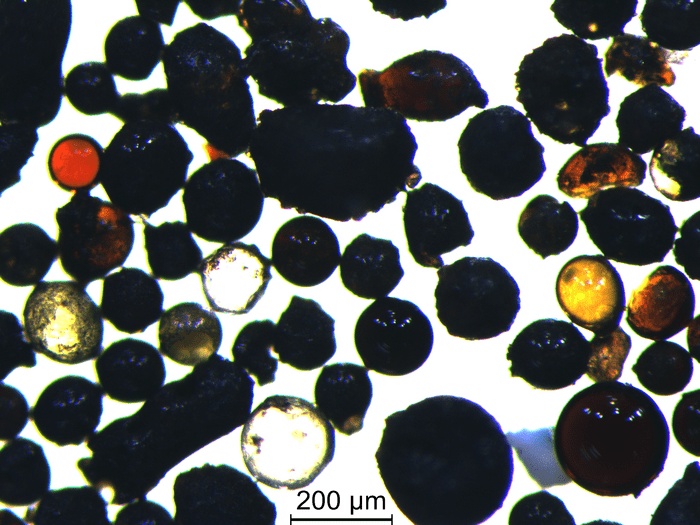Death from the skies may not come in an isolated event. Instead, major asteroid impacts may be accompanied by smaller objects hitting the Earth – and the Moon too. The ages of lunar glass collected by the Chang’e-5 mission indicate clusters of craters coinciding with the Chicxulub event, plus two other periods associated with large terrestrial impacts.
Just last month, a crater was discovered off the west coast of Africa dated to within a million years of the Chicxulub crater. The smaller crater’s discoverers thought the similarity in timing might mean the Earth was hit by a double asteroid 65 million years ago, larger counterparts to the Dimorphos/Didymos pair NASA targeted with yesterday’s DART mission. Alternatively, a disturbance in the asteroid belt may have caused a number of asteroids to enter Earth-crossing paths at the same time, eventually causing multiple hits to our planet.
That scenario is looking considerably more likely thanks to an analysis of glass beads produced by cosmic impacts and returned in Chang’e-5’s samples. Such beads are rare on Earth, with our atmosphere protecting us from small asteroids and sometimes breaking up medium-sized ones. Those that do form get buried by geologic processes. On the Moon, however, they are abundant.
“We combined a wide range of microscopic analytical techniques, numerical modelling, and geological surveys to determine how these microscopic glass beads from the Moon were formed and when,” Professor Alexander Nemchin of Curtin University in a statement. “We found that some of the age groups of the lunar glass beads coincide precisely with the ages of some of the largest terrestrial impact crater events, including the Chicxulub impact crater responsible for the dinosaur extinction event.”
The authors established the beads’ ages by measuring how much of the uranium they contain has decayed to lead. Using the sizes of nearby craters, they created statistical models of the chances each was responsible for the beads being studied.
Chang’e-5 glass beads. Image Credit: Beijing SHRIMP Center, Institute of Geology, CAGS
The technique produced quite wide error bars for the craters’ ages, but the authors note; “14 of the 30 craters have model ages between 53 ± 12 and 73 ± 10 [million years ago], including the second largest crater.”
Curtin’s Dr Katarina Miljkovic told IFLScience the most likely explanation for this was that something disturbed a main belt asteroid, bringing it into an Earth-crossing orbit. An event such as a collision with a smaller object caused it to break into many pieces. The largest of these ended the Cretaceous Era, and small pieces struck both the Earth and the Moon. “We see a family of meteorites that are alike and probably come from the main source, so we know break-ups like this happen,” she said. “The chances of disturbing a number of asteroids so that all end up crossing the Earth’s path is much smaller, but this is an educated guess.”
Miljkovic added that “Any number of things” could have been responsible for changing the parent asteroid’s orbit.
The authors also report an uptick in beads around 34 million years old. This coincides with the 100-kilometer (60-mile) wide Popigai crater and three smaller sites, collectively known as the Late Eocene craters. The largest crater in Chang’e-5’s vicinity is estimated at 479 million years old, coinciding with the Ordovician craters on Earth, suggesting displaced asteroids around both those times.
The study was restricted by the beads all being from one location, where a lava flow around 2 billion years ago covered whatever had been created previously. “We caught a snippet of history, but probably not a complete picture.” Miljkovic told IFLScience. For that, beads will need to be collected from a wider range of lunar locations.
This paper was published in Science Advances (Open Access).
Source Link: Tiny Glass Beads Reveal Timing Of Lunar Craters May Coincide With Major Impacts On Earth
